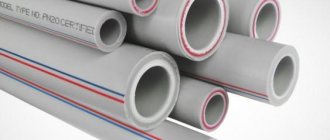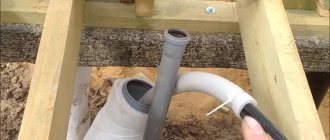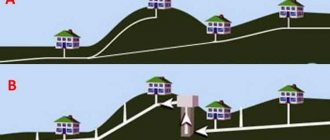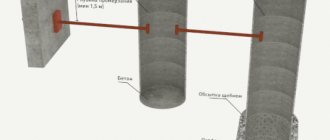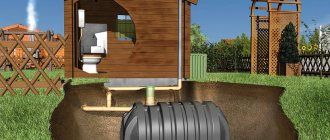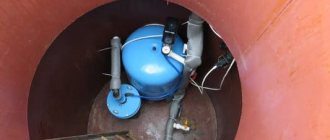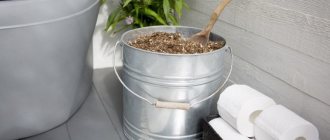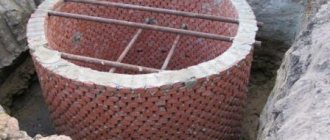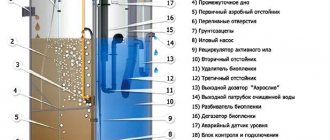Caisson: what it is, choice of design. A caisson for a well is a device that protects it from the negative effects of many external factors.
A special chamber is designed to equip the wellhead, which is located underground. The structure is installed above the water intake for free access to it in case of repair and installation work. There are different types of caissons, which differ in their properties. You can install the caisson yourself if you follow the basic rules.
General information
Considering the caisson, what it is in construction, the structure can be defined as a hollow sealed chamber, mostly round in shape with a diameter of approximately 1 m, which is installed on top of the well pump.
Most often, the caisson is placed in a hole dug in a circle around the casing, with the casing's mouth located at a depth of 1-5 m. At the bottom of the device there is a hole for the well, at the top it is closed with a hatch for insulation. A ladder must be installed inside, which allows you to descend to the downhole equipment.
The ladder allows you to conveniently descend for installation, repair or routine maintenance of equipment Source eurolos.ru
Why a caisson is needed for a well is to protect the pumping station from bad weather conditions, seasonal temperature fluctuations, and the penetration of underground, waste and melt water.
Functions of the caisson
At low temperatures, water turns into ice. As a rule, groundwater is located below the soil freezing level, but pumping equipment is installed on the surface and it is strongly exposed to the negative effects of low temperatures: the water in the system freezes, the hoses burst, the pump fails, and the water supply system stops working.
Therefore, when considering a caisson for a well, what it is and why it is needed, we can briefly say that it is an insulated room that does not allow downhole equipment to freeze. The following is installed inside the structure:
- pump for water intake;
- filter installation;
- shut-off valves;
- battery;
- pressure gauge;
- automation device;
- expansion tank.
To install a caisson, it is best to contact specialists; it is almost impossible to carry out the installation work yourself
. Source provodoprovod.ru The installation of a caisson for a well is not required only if the equipment is located near the heated room. In this case, you can get free access to all elements of the pumping system, but the strong noise of the devices brings some discomfort.
In the process of organizing a well, a water pipe is installed in a caisson to a depth of 1-2 m. This allows you to create effective protection from low temperatures.
Metal caisson
The metal camera is also very popular among consumers.
The advantages of the products include:
1.completely sealed structure, so electrical equipment can be installed.
2.easy installation.
3.high strength, does not deform from external influences.
4.strong fixation in the soil, the structure will not float when flooded.
A caisson made of this material has a service life of up to 50 years.
Important! In order for the caisson to serve for many years, the internal walls should be treated with a special anti-corrosion agent, and water should be drained correctly.
Design disadvantages:
1.heavy weight of the device.
2.Welding is required when installing.
3.formation of corrosion on the surface.
Main types
Caissons for wells come in various geometric shapes, but cylindrical and round designs are the most popular. Sometimes you can find combined caissons; they have the shape of a rectangle at the bottom and a circle at the top.
Taking into account the material, the following protective systems are distinguished:
- plastic;
- iron;
- reinforced concrete.
In rare cases, brick is used for construction.
The materials used to make the caisson determine its performance. They all have their pros and cons.
Caissons come in different shapes, but mostly round ones are installed Source lider-skvajin.ru
Plastic
The most popular are plastic products. This material has excellent tightness, caissons made of plastic are easy to install, the surface is strong, durable, while it is absolutely not subject to corrosive processes and is inexpensive.
The structures are made from a solid cylinder or polymer sheet material 6-35 mm thick, taking into account GOST regulations; the material usually contains plasticized polyvinyl chloride, polyethylene, fiberglass, and polypropylene.
Main advantages:
- The material retains its characteristics for a long time, it is not exposed to rust and does not rot.
- The service life of plastic products is about 30 years (taking into account the wall thickness).
- The surface allows for excellent tightness and waterproofing.
This is what classic plastic caissons look like Source ytimg.com
- The low weight of the product facilitates the delivery and installation process. The medium-sized structure can be mounted without the use of special equipment.
- Plastic has excellent thermal insulation properties, due to which an additional insulating layer is not required in areas with moderate climatic conditions.
With all the described advantages, plastic structures are relatively inexpensive.
Flaws:
- Due to its low mass, during floods, a plastic product can rise from the ground. Therefore, a cement-sand cushion is poured into the base of the tank, this leads to an increase in the cost of the caisson.
- There is a possibility of surface deformation due to soil compression. This problem is partly solved by installing stiffeners.
Metal
The metal caisson for the well is not so popular. These products are characterized by high strength and maintainability. Taking into account GOST regulations, iron structures are made of steel with a thickness of 5-10 mm.
Insulation of the metal caisson is mandatory, but this can serve as part of the landscape design Source strojdvor.ru
Carrying out anti-corrosion, hydro- and thermal insulation work during installation is a mandatory requirement, in particular for products that are made of stainless steel.
Attention! The ideal shape is round, since this design has a minimum of connections.
Main advantages:
- Long service time. When all conditions of installation and further operation are met, iron structures last about 50 years, this can be compared with the service period of a directly dug well.
- Increased strength. Steel can better withstand pressure, unlike plastic products, this significantly reduces the possibility of cracks forming on the surface during soil heaving.
- Much easier to install, unlike reinforced concrete products.
- Good sealing. If there are no cracks in the joints, then the iron structure is guaranteed to be able to protect the installed equipment from the penetration of groundwater.
- Sustainable location. The relatively large weight does not allow the caisson to rise during floods.
But if the installation technology is not followed, the sealed metal caisson may float up Source domkesson.ru
See also: Catalog of companies that specialize in water supply, sewerage and related work
Flaws:
- The main disadvantage of metal structures is their susceptibility to the development of corrosion processes. The need for waterproofing leads to additional costs.
- A factory-made iron caisson for a well (especially one made of stainless steel) is much more expensive, unlike plastic products.
- The relatively large mass, which prevents swelling, sometimes creates certain difficulties during installation. Most often, during installation it is necessary to use special equipment.
- Low thermal conductivity. To prevent freezing, iron structures must be insulated; this also increases the cost of the caisson.
Reinforced concrete
Considering what a caisson for wells is and the materials for its manufacture, it is necessary to note reinforced concrete structures, which are not very popular.
Concrete rings are difficult to install and impractical to operate Source beton-house.com
There are several options for these products:
- The structure is made by pouring concrete into the formwork with reinforcement in it. Filling wells come in any shape.
- During installation, reinforced concrete rings are laid on top of each other on a previously prepared foundation. The individual elements are connected using a waterproofing compound. When the caisson reaches the required height, a slab with a hatch is installed on top.
A caisson for a well made using the first method is characterized by high strength, but it also has many shortcomings. The main ones are low hygroscopicity and large mass, because of this the caisson can sink into the ground.
Attention! Due to the large number of shortcomings, reinforced concrete structures must strictly comply with the GOST 8020-90 regulations: in terms of water permeability, frost resistance, actual strength, corrosion protection, concrete layer thickness, steel grades for reinforcement.
When installing concrete rings you cannot do without special equipment Source ytimg.com
Main advantages:
- Long service time. If the technological process and subsequent operating conditions are observed, reinforced concrete caissons last up to 100 years.
- Increased strength. Even serious ground displacement will not damage the integrity of the product.
- Relatively inexpensive cost of manufactured reinforced concrete chambers.
- The large weight successfully prevents the structure from floating up during an increase in groundwater levels.
Flaws:
- The main disadvantage of reinforced concrete products is the connections between the installed caisson elements; this is the most vulnerable link.
- Poor waterproofing. Concrete surfaces are hygroscopic; water that gets inside over time destroys the walls of the rings and causes corrosion in the reinforcement frame.
- Very large weight often leads to subsidence of the well into the ground, which sometimes leads to disruption of the operation of downhole equipment. The significant mass also creates certain difficulties during transportation and installation.
- Poor thermal insulation. Concrete surfaces must be insulated.
If you install it yourself, there is a high risk of leaks Source provodoprovod.ru
Plastic caisson
Plastic is considered a popular material for making caissons. The camera material has many positive characteristics.
All devices can have different geometric shapes.
The advantages of the products are:
1.low cost compared to analogues made of steel and reinforced concrete.
2.light weight of the caisson, making installation and transportation easy.
3.long service life, because corrosion does not form on the surface, there is no need to insulate the chamber.
4.high thermal insulation of plastic allows you to maintain the temperature of the liquid inside the container above five degrees, thus the water in the caisson does not freeze.
5.high level of waterproofing.
The big and only drawback is considered to be the low rigidity of the structure, so it can deform and break the equipment. In this case, backfilling the well around the perimeter, cement mortar is used to strengthen the walls. The cement layer should be eighty millimeters.
Installation Features
The installation process is almost the same for any type of protective boxes, but there are certain nuances. The hole for the caisson is dug at least 50 cm larger than the structure being installed. This allows you to accurately level the product and adjust the alignment of the pipes. This will also help to insulate the walls or secure them if it is a plastic caisson device.
The well casing is cut to the height of the structure floor. Sand is poured into the bottom of the hole in a layer of 25-35 cm and watered to compact it. A reinforced concrete slab is laid on top.
Attention! You can pre-install fasteners for the caisson on the slab. But there is a big risk of making a mistake. Therefore, it is best to first put the product in place, and then make holes for fastening. Today there are many expanding fastening methods, so there will be no problems with the choice.
During the installation of any caisson, it is imperative to follow the technological process Source burenie-m.ru
Work methodology
It is necessary to weld a sleeve with a larger diameter compared to the pipe into the hole prepared at the previous stage. The length of the latter should be 15 cm. Before this, a sleeve is put on the pipe to make sure that you can provide a small margin.
The pipe is cut at a height of 500 mm from the bottom. The caisson is prepared in advance. Barrels are welded into its walls to lead the pipes into the trench. One of them is intended for cable entry, while the others are for pipe exit. The caisson is installed above the pit so that the axes of the sleeve and casing pipe coincide.
The structure is located on beams, which must be pulled out and the product lowered into the pit through a pipe. The latter will act as a guide. The caisson must be positioned horizontally; for this, beams are placed between the walls of the pit and the container. The sleeve is welded around the perimeter to the pipe, and then the pipes are inserted inside through the installed nipples.
Welding seams must be treated with a primer. If you use HDPE 40 pipe in your work, you will need a 1.5-inch nipple. When HDPE 32 pipe is used, the nipple diameter will be 1.25 inches.
If the pipes pass through with difficulty, then the inner surface of the nipple should be processed with a file. The inside of the pipe is sealed by a transition with an internal thread. To power the pump, an electrical cable must be threaded through one of the pipes. This will provide a sealed structure that will protect the wellhead. In order to achieve better results, it is necessary to install a second cover made of foam and plywood. It is removed from the first by 50 cm. The upper part of the structure is additionally thermally insulated.
Video description
The features of installing a concrete caisson are described in detail in this video:
Installation of a metal structure
Installation of an iron structure will necessarily require a concrete slab as a foundation. Before fastening the structure from the outside, it is finished with waterproofing, and the inside is coated with a primer. This is a mandatory requirement even for stainless steel. Insulation is also necessary.
Step-by-step instructions on how to make a caisson for a well:
- a hole is dug.
- The foundation is prepared - a sand and gravel cushion, and a reinforced concrete slab is installed on top.
- The well casing is cut to height.
Casing pipes must be selected taking into account the diameter of the pressure pipeline Source ytimg.com
- A caisson is installed on top of the pit on metal supports, and the pipes of the sleeve and the well must coincide.
- additional trenches are dug to bring the pipeline to the house.
- All communication systems are installed.
- thermal insulation is attached.
- the structure is covered with earth.
When considering a caisson for a well, what kind of product it is and how it will be used, it is necessary to take into account differences in the design, therefore the installation diagram sometimes changes taking into account specific tasks and conditions. But it is recommended to dig trenches for connecting communications after attaching the caisson - simply jumping over various ditches at this time is not very convenient.
Caisson device
To install the caisson, a pit is dug around the well, the depth of which is 2 m. Its dimensions should be larger than the dimensions of the tank by 10 cm around the perimeter. The pit is prepared taking into account that the neck of the structure is located 10 cm above the surface level. This will prevent rain and surface water from getting inside.
Next, you can begin installation. At the bottom, the place where the hole for the casing pipe will be located is indicated. It can be shifted in any direction, taking into account personal requirements. If a hydraulic accumulator is located in the caisson, then the hole for the pipe should be shifted from the center. This is necessary so that after installing the pressure tank it will be possible to lower the tool into the hatch. Hydraulic and cable outlets must go to the point where the pipeline enters the building.
Video description
Why the caisson was compressed is shown in this video:
Attention! In this case, hydro- and thermal insulation will not be required, but protection against compression by soil is required.
Filling a plastic caisson with concrete is mandatory. Source moikolodets.ru
To do this, the gap between the walls of the pit and the box is filled with concrete. High-strength mixture quality is not necessary in this case. As a rule, the solution is mixed in a proportion of 5 parts sand and 1 part concrete. This procedure is mandatory, even if there are stiffening ribs on the plastic box.
Features of installing a caisson made of plastic
The main feature is the sealing of the joint between the sleeve and the casing pipe. To do this, they do not use welding, but special glue.
Pipes must enter the chamber through couplings, which are covered with lids for sealing.
A plastic caisson does not require waterproofing or insulation, but requires protection from deformation by soil. In this case, the gap between the pit and the chamber is filled with cement, which is diluted 1 to 5 (cement and sand mixture).
If there are stiffening ribs on the structure, the caisson should still be strengthened.
Video description
To see what mistakes can happen when installing a caisson, watch this video:
Also, the diameter of the installed casing tube must be 500 mm larger than the cross-section of the pressure pipe, the height of the caisson itself must be at least 2400 cm, while the upper chamber must be above ground level to prevent rainwater from entering it. For the same reason, the hatch must be sealed.
An installed caisson on the territory of a private house should not disturb residents Source strojdvor.ru
Briefly about the main thing
A caisson is a sealed chamber of a round, rectangular or square shape that isolates the wellhead to protect it from groundwater. This allows you to protect against the penetration of dirty water into your home water supply.
After determining what a caisson is and what types it comes in, the problem becomes which material is better to choose:
- If the well is located on calm soil with little ground movement and low groundwater, the best option is to install a plastic structure. The goal of saving money on organizing a caisson made of plastic is justified, but it is not recommended to purchase very cheap models; it is worth taking a closer look at products made of high-density polyethylene and stiffeners.
- Installation of heavier iron boxes is advisable in unstable soil with high groundwater levels. Metal is more reliable than plastic, and repairs to steel products are much cheaper, unlike polymer ones. It is recommended to choose stainless steel caissons, but they are more expensive.
- Reinforced concrete rings can only be recommended with a stretch, since concrete, due to its hygroscopicity, is poorly suited for these structures.
Organizing a caisson allows you to solve many problems. The supply of water to the house immediately becomes much safer; the owners will not worry that they will be left without water when frost sets in. In a summer cottage, this structure is often used as a cellar.
Ratings 0
Summarizing
Installing a caisson simultaneously solves many problems. The water supply at home immediately becomes safer; owners do not have to worry about being without water when frost sets in. At the dacha, this device can be used as a warehouse or cellar, equipping it with a reliable lock.
Now you can buy a durable, ready-made plastic or metal caisson, or make it yourself. The choice is up to you. The main thing is not to forget that without this equipment, normal operation of the well is simply impossible.
